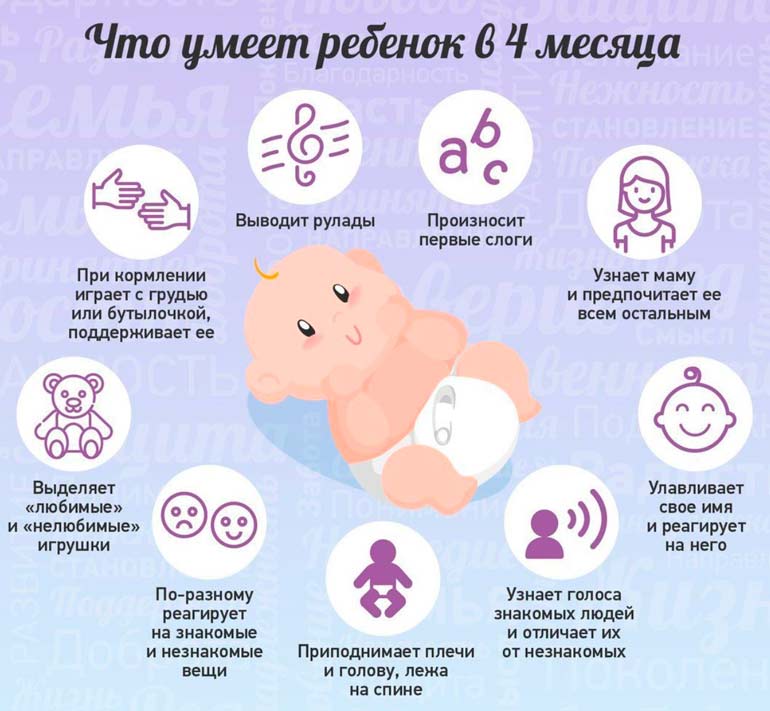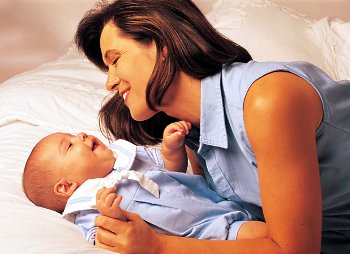The fourth month of a baby’s life is a time of great changes, especially in psychological and emotional development. Most children by this age have already experienced painful moments associated with colic. The work of the gastrointestinal tract has become stable and now the baby is more and more immersed in the world around him, learning to respond to it and learn.

Physiological development at 4 months of life
Height and weight
A child at 4 months still has a large increase in weight, due to low motor activity. A child can gain up to 750 g for this month. Normally, body weight at 4 months is 6 - 7 kg (± 1 kg), height 60 - 63 cm (± 3 cm).
Reflexes
In a child at four months, the reflexes of a newborn continue to fade:
- On the basis of Robinson's unconditional grasping reflex, purposeful grasp is formed: the baby grabs the objects that he sees in front of him and holds in his hand. A good expression of this reflex promises the rapid development of fine motor skills.
- Moro's reflex: if you slap sharply on the surface on which the child lies, he throws up his arms with open hands, and then collects them again on his chest. This reflex begins to fade away in 4 - 5 months, so for some of the babies in the fourth month it can still persist, while someone else will not have it.
- Bauer crawl reflex: a child lying on his stomach tries to crawl if he supports his heels. From 4 months, this reflex fades, but if you stimulate it, then by 5 months the baby will be able to crawl on its own.
- By the end of 4 months, the child should not have observed:
- reflex of Talent: with the index finger, spend along the spine of the child, 1 cm to the left and right of the midline, from top to bottom. In this case, the baby bends the back;
- as well as the reflex Reboot: swiping the finger along the spinous processes of the spine from top to bottom. The baby at the same time bends the back and screams (do not do it yourself!).
The presence of these reflexes after 4 months may indicate neurological disorders and requires examination by a neurologist.
Core skills
In addition, the normal physical development of the child during this period is characterized by the presence of the following skills:
- Child with ease flips from the abdomen to the barrel and back;
- Lying on the tummy can rise on the arms, resting only on the palm of your hand and hold your head;
- He sits down when he is pulled by the handles and confidently holds his head. But do not forget that his back has not yet strengthened, so it is too early to plant the baby;
- While supporting the child by the armpits, he rests against the toes and pushes off the surface;
- Disappears hypertonicity in the hands, but in the legs can still be stored;
- The baby's palms are opened almost all the time. He can put them together, clap them on something;
- Able to hold an object in his hand for almost half a minute. Knows how to shake a rattle so that it rattles;
- The child can deliberately stick a finger in his mouth;
- When feeding, the baby itself supports the mother's breast.

Psycho-emotional development at four months
- The baby’s revitalization complex is becoming increasingly apparent: in response to his mother’s voice, he actively moves his arms and legs, smiles, babbles. It can pronounce sounds similar to “p”, “b”, “m”, as well as open vowels “o”, “a”. Now the child can notice a reaction in the form of laughter or smile not only on someone's face, but also on a new toy. The baby learns its name and begins to respond to it.
- The child’s thinking begins to establish elementary causal relationships, for example, when he sees his mother’s chest, the baby falls silent and looks at her in anticipation of feeding.
- The baby at 4 months old is already able to experience fear, joy, resentment, curiosity.
- The kid begins to pay more attention to his body, he examines the pens, plays with them, pulls a leg in his mouth. The child likes to feel his face, hair. He likes to look at his reflection in the mirror.
- The child already recognizes all relatives and friends, while especially highlighting his mother. He fully personifies her with himself, therefore he needs constant tactile and emotional contact with her. He is happy if mom is fun and sad or crying, if she is in a bad mood.
- With strangers, a child at 4 months of age behaves wary. If mom, for example, puts on a hat or glasses, he will not recognize her. And after she removes them, the baby will be very surprised and will not understand how this could happen. A child may be frightened or interested in seeing a stranger.
- The intensive psychological development of the baby at this age is associated with a new step in visual and auditory perception. A child at 4 months old no longer just sees, he follows his eyes with an object that is moving. But if he disappears from the field of view, then the baby immediately forgets about him. If you again show him the disappeared item, then the baby will recognize him.
We read a detailed article: What a child can and should be able to do at 4 months
Vision
The baby's vision becomes more susceptible to color. At first, the child likes yellow and red, then green and blue. Bright and clear shades are perceived by the child better than half-tones or multi-color combinations. Therefore, it is important not to overdo it with bright toys. It is better to buy those that contain no more than 3 to 4 colors. Oversaturated toys will tire the baby faster.

Hearing
Hearing for a child becomes an important guide to the world. The kid is already turning the head in the direction from which sounds are heard. He distinguishes the voice of the mother from the voice of the father or other relatives. He understands that he hears the voice of a friend or stranger. The kid listens when music plays, shakes his head to the beat, may prefer some kind of melody or song. High tones are unpleasant for a child, and low and rhythmic ones have a calming effect. But while the baby distinguishes only a few whole tones. Therefore, at four months, the child is better to include works performed by one instrument. It is better if the melody is rhythmic, under which you can clap your hands in front of the baby or beat a tambourine.
In the period from 4 to 6 months, it is very important to talk with the baby, comment on everything that you see at home and on the alley, read and tell him tales, show pictures with words (Doman’s cards) - this is all a guarantee that the child will begin to speak earlier. It is useful to develop a child's ability to speech imitation. Repeat after the child the sounds that he babbles. After some time, the child will also repeat after you.
If you can’t
Everything that a baby can do at 4 months of the above may appear a little earlier or a little later, but there are skills, the absence of which in this period of development should alert:
- The child does not grab or hold objects in his hand;
- Does not roll over onto the tummy from the back (how to teach to turn over);
- Lying on the tummy does not rise on the handles;
- When pulling the child by the handles, when he lies on his back, the head deviates back;
- Does not rely on toes while maintaining upright;
- Does not react to other people, does not show emotions: does not smile, is not angry, does not laugh, is not surprised. Not happy if they play with him.
Food and sleep
On hot water
If the baby is on breastfeedingit is preferable to continue to feed him on demand. Do not count the number of feedings and worry about how much the child eats, if he has a normal weight gain, and his mother has enough milk.
The opinions of pediatricians are increasingly reduced to the fact that feeding up to 6 months is not necessary, since breast milk and modern milk formulas fully satisfy the needs of crumbs in all vitamins and minerals. Some old-fashioned doctors give advice to mothers to introduce juices and fruit purees from 4 months, which supposedly compensate for the lack of certain vitamins in the baby. As already mentioned above, the child receives everything necessary with breast milk and the mixture, and from juices the risk of allergies increases, as well as the acidity of the gastric juice, which leads to frequent regurgitation.
We also read: when to introduce complementary foods
As for the fruit puree, it is better to introduce them only after the vegetable: firstly, because after sweet food many children refuse to eat a vegetable tasteless mixture, and secondly, vegetable purees (cauliflower, zucchini) contain more fiber, which preferred for first feeding.
On artificial feeding
With artificial feeding, the introduction of juice from 4 months is allowed. You need to start giving it with a few drops, up to 20 - 30 g per day, diluting 1: 1 with boiled water. (About the first juices)
Feeding with the mixture can also be done on demand, about 6 to 7 feedings per day should be obtained, and the volume of the mixture is 1/7 of the baby’s weight, that is, up to 1 liter per day, about 150-160 ml per feeding.
Sleep
How much a child sleeps for 4 months: the need for sleep in children of 4 months is 15 hours a day, at night - 10 hours, and the rest of the time is 3 days sleep. Some babies can already oversleep all night, but most often they still have to wake up 2-3 times to feed.
The best time for laying at night is 19-21 hours, later a child at this age will already be too tired. Gradually, you need to establish the mode of daytime sleep, if the baby falls asleep at certain hours, then he will not overwork and will be ready for a night's sleep.
How to help your baby grow

The development of a child of 4 months is especially dependent on close contact with the mother. Since there are no specific games for kids at this age, the most important thing for them is constant communication, getting to know the world around them. If possible, carry the crumbs everywhere with you in your arms, in carrying, in a sling or in a stroller. Do not use the “kangaroo” yet, the baby's spine up to 6 months old is not ready yet for this method of movement.
Engage in dialogue with your child. Let you still not understand what the baby is “talking”, it is important that the child feels that you are listening to him, talking to him. Tell the crumb about everything that you do at home, show objects, explain why they are needed in action. What are the colors of the things you show your child? For “grabbing” games, use not only toys, but various safe objects that you can touch, mash, smell and throw.
The baby probably already learned all the toys bought at birth and it's time to update them. Now he is interested not only in rattles. A four-month-old child will love rubber tweeters, small dolls, musical toys with buttons, soft toys with ball filling. For the development of tactile sensations and fine motor skills, developmental rugs that can be made of multi-colored shreds of different textures (velvet, silk, velveteen, wool) are well suited.
Games with a child
1. The game "Ku-ku!": you close your eyes or hide behind the back of the crib, and then look out, saying "cuckoo, here I am!".
2. "Okay": set the baby on his knees, take his hands and show how to clap his hands, saying: Frogs - Frogs, Where were you? By Grandma.
The game promotes faster opening of the palm, which activates the development of the brain and fine motor skills.
3. "The horned goat"
“There is a horned goat behind the little guys,
Who doesn’t eat porridge, doesn’t drink milk,
Gored, gored, gored ...! ”
This fun game is pretty fun for kids, because it causes not fear, but laughter.
4. "Magpie-raven"
A game that stimulates the work of the gastrointestinal tract. The points responsible for the small intestine are projected into the center of the palm, from here begin circular movements in a clockwise direction, saying: “Magpie - crow cooked porridge, fed the children.” On the word "helm" you need to stop between the ring and middle fingers - this is the projection of the rectum. Then, gently squeezing the fingertips alternately, starting with the little finger, continue to pronounce: "This gave, this given ...". Each finger corresponds to a specific organ: the little finger - the heart, the nameless - the nervous system, the middle - the liver, the index - the stomach. The thumb is responsible for the brain, so it must be properly rumpled, saying: “But I didn’t give it!”
Continue to massage and temper your child. Do gymnastics exercises to help your baby learn how to turn on his stomach and other skills.
READ ALSO: 4-month baby day regimen
Video: Child Development 4th month of life
A full calendar of the development of the child in one article “development up to a year by months” -https://kid.htgetrid.com/en/razvitie-rebenka-do-goda/razvitie-rebenka-do-goda-po-mesyatsam.html









This is a normal occurrence for children 3-4 months of age who are exclusively breastfed, if the stool is still soft, the child does not need enemas and laxatives.
Hello! And mine in his 4 months. weighs 9 kg and height 70cm. And how does he roll over? And he was born with a weight of 4,700. Therefore, we have the norm in weight. True in the bath like a dolphin swims such somersaults))) gets up, but on land, well, not how?
It was very interesting to read. Thank!
I took a lot of new things for myself.
We will continue to follow the article.
It is impossible to plant a child on his knees at 4 months old and play games in this way, the author’s complete lack of professionalism.